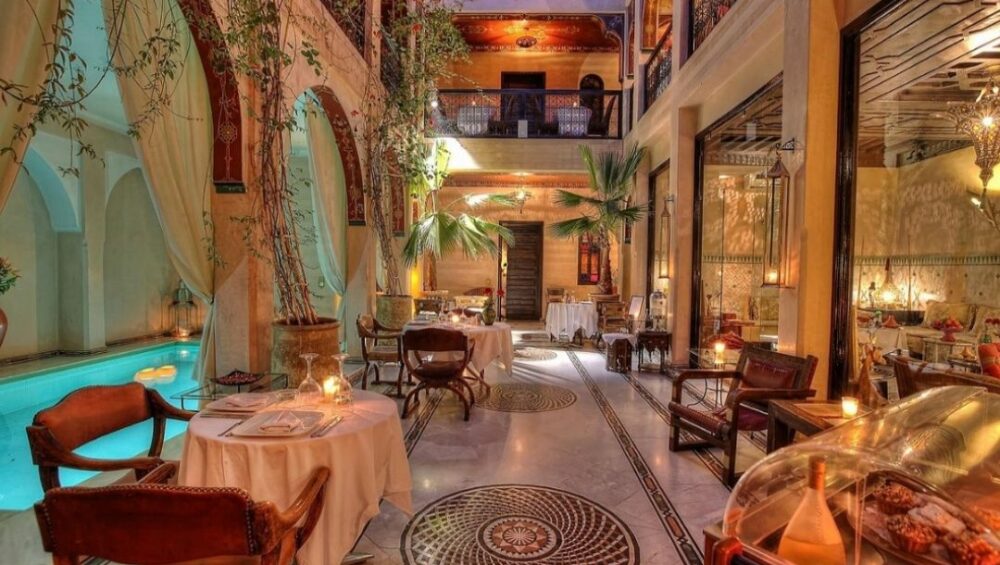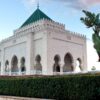Introduction
Morocco’s rich cultural heritage, vibrant landscapes, and diverse history captivate travelers worldwide. Nestled at the crossroads of Europe and Africa, this North African country offers an enticing mix of ancient traditions and modernity.
From bustling markets and historical sites to breathtaking natural wonders, Morocco is a treasure trove to be explored. This article highlights the 15 best places to visit in Morocco. Showcasing their unique attractions, cultural importance, and unforgettable experiences.
Tourism is crucial to Morocco’s economy, providing jobs and promoting cultural exchange. The country’s picturesque cities, stunning landscapes, and warm hospitality make it a prime destination for adventurers and culture enthusiasts. Each destination in Morocco has its own story to tell, inviting visitors to immerse themselves in its traditions, cuisine, and beautiful scenery.
1. Marrakech
Historical Significance of Marrakech
Marrakech, often commonly known as the Red City due to its distinct red sandstone buildings, is a vibrant hub of history and culture. Founded in 1070, Marrakech has been a significant political and cultural center for centuries. The city’s medina, a UNESCO World Heritage site, is a labyrinth of narrow alleyways filled with bustling souks, historical landmarks, and picturesque Riads. With its rich history and enchanting atmosphere, Marrakech is a must-visit destination in Morocco.
Key Attractions: Jemaa el-Fnaa and Koutoubia Mosque
The heart of Marrakech is the bustling Jemaa el-Fnaa square, where visitors can experience the lively atmosphere filled with street performers, snake charmers, and local food vendors. As the sun sets, the square transforms into a vibrant dining hub, offering an array of Moroccan cuisine. Nearby, the Koutoubia Mosque is an architectural marvel with its impressive minaret, visible from various parts of the city. These attractions encapsulate the essence of Marrakech’s charm and allure.
2. Fes
Exploring the Ancient Medina
Fes is revered as Morocco’s cultural and spiritual capital. It is known for its well-preserved medieval architecture and intricate designs. The Fes el-Bali medina, another UNESCO World Heritage site, is the largest car-free urban area in the world, allowing visitors to explore its narrow, winding streets freely.
This area features traditional tanneries, artisan workshops, and lively markets offering everything from spices to handcrafted ceramics.
Cultural Heritage: Al Quaraouiyine University
Fes is home to the world’s oldest university, Al Quaraouiyine, established in 859 AD. This institution has been a center for Islamic education and scholarship for over a millennium. Visitors can admire the stunning architecture of the university, which reflects the artistry of Moroccan design. Fes offers a glimpse into Morocco’s rich academic and cultural history, making it a vital stop for those interested in the Nation’s heritage.
3. Chefchaouen
Unique Blue-Rinsed Streets
Chefchaouen, known as the Blue City, is famous for its stunning blue-washed buildings, which reflect the charm of the Rif Mountains. This picturesque town is a retreat offering a peaceful atmosphere and scenic views. The blue hues symbolize peace and spirituality, making it a favorite spot for photographers and travelers seeking tranquility.
Outdoor Activities in the Rif Mountains
Surrounded by breathtaking mountain scenery, Chefchaouen offers numerous hiking and trekking opportunities for outdoor enthusiasts. Trails lead to stunning viewpoints and natural springs, allowing visitors to put themselves in the region’s natural beauty. The combination of captivating landscapes and the town’s unique character makes Chefchaouen a must-see destination for nature lovers and those looking to experience Morocco’s serene side.
4. Casablanca
Modern Architecture vs. Traditional Heritage
Casablanca is Morocco’s largest city and economic capital. It showcases a blend of modern architecture and traditional Moroccan culture. The City is characterized by its Art Deco buildings, contemporary skyscrapers, and traditional souks. While it may not hold the same historical significance as other cities, Casablanca offers a vibrant urban experience with plenty of shopping, dining, and entertainment options.
The Iconic Hassan II Mosque
The crown jewel of Casablanca is the Hassan II Mosque, which boasts the tallest minaret in the world. This architectural masterpiece, constructed on the Atlantic Ocean, can accommodate up to 25,000 worshippers and features stunning mosaics, intricate carvings, and a magnificent prayer hall. The mosque’s grandeur and location make it a must-visit attraction that exemplifies Morocco’s rich Islamic heritage.
5. Essaouira
Historical Significance as a Port City
Essaouira, a coastal city on the Atlantic, is known for its historical significance as a trading port. Fortified walls surround the City, and its vibrant medina overflows with artisan shops, galleries, and seafood restaurants. Essaouira has a relaxed atmosphere, making it an ideal destination for those seeking a break from the hustle and bustle of urban life.
Vibrant Arts and Music Scene
Essaouira is also recognized for its rich artistic culture. It hosts several festivals annually, including the Gnaoua World Music Festival. The city is home to numerous artists and musicians, contributing to its vibrant arts scene. Visitors can enjoy live performances, explore local art galleries, and experience the unique blend of Moroccan and international influences that define Essaouira’s cultural landscape.
6. Atlas Mountains
Trekking Opportunities and Scenic Beauty
The Atlas Mountains offer some of the most breathtaking landscapes in Morocco, with rugged peaks, lush valleys, and traditional Berber villages. This mountain range is a paradise for trekking enthusiasts, providing trails for all skill levels. The Toubkal National Park, home to Mount Toubkal, the highest peak in North Africa, is a popular destination for hikers aiming to reach its summit.
Berber Culture and Hospitality
Exploring the Atlas Mountains provides a unique opportunity to experience Berber culture firsthand. Visitors can stay in traditional guesthouses or gîtes, where they are welcomed with warm hospitality and authentic Berber cuisine. Engaging with local communities, visitors can learn about traditional crafts, customs, and the significance of the mountains in Berber life.
7. Merzouga and the Sahara Desert
Sand Dunes and Camel Treks
Merzouga is a small village located near the Erg Chebbi dunes, one of the most iconic landscapes in the Sahara Desert. The towering dunes, often reaching 150 meters, offer a stunning backdrop for photography and adventure. Camel trekking is a popular activity, allowing visitors to explore the desert and experience the tranquility of the vast landscape.
Stargazing in the Desert
One of the highlights of visiting Merzouga is stargazing in the clear desert skies. With minimal light pollution, the Sahara offers breathtaking views of the Milky Way and countless stars. Many visitors camp in the desert under the stars, creating unforgettable memories of their time in Morocco’s captivating wilderness.
8. Rabat
Political and Historical Capital of Morocco
As the political and, administrative capital, Rabat is often overshadowed by other Moroccan cities but boasts a unique charm and historical significance.
Key Attractions: Kasbah of the Udayas and Hassan Tower
The Kasbah of the Udayas is a historical fortress overlooking the Bou Regreg River, offering picturesque views and a glimpse into Morocco’s past. Nearby, the Hassan Tower is an unfinished minaret from the 12th century, symbolizing Rabat’s historical ambitions. Together, these attractions highlight the city’s rich heritage and make it an intriguing destination for history enthusiasts.
9. Agadir
Beach Resorts and Leisure Activities
Agadir is known for its beautiful beaches and modern resort amenities, making it a popular destination for sun-seekers. The city’s beachfront promenade is lined with hotels, restaurants, and cafes, providing ample opportunities for relaxation and entertainment. Agadir’s warm climate and stunning coastline attract visitors year-round, making it a vibrant hub for leisure activities.
Rebuilding After the Earthquake
In 1960, Agadir was devastated by a catastrophic earthquake that led to significant loss of life and destruction. However, the city has been rebuilt, showcasing modern architecture and urban planning. The resilience of Agadir’s residents and the city’s transformation into a thriving tourist destination are testaments to its enduring spirit.
10. Tangier
Gateway Between Europe and Africa
Tangier, strategically located at the entrance of the Strait of Gibraltar, has long been a melting pot of cultures and influences. The city’s history as a port has made it a crucial point of exchange between Europe and Africa. Today, Tangier offers a unique blend of Moroccan and international influences, evident in its architecture, cuisine, and lifestyle.
Exploring the Kasbah and Medina
The Kasbah of Tangier, perched on a hill overlooking the ocean, is a historic district filled with narrow streets, charming squares, and stunning views. The Medina is a vibrant marketplace where visitors can discover local crafts, spices, and traditional foods. Exploring Tangier allows travelers to experience the city’s rich history and cultural diversity firsthand.
11. Ouarzazate
Hollywood of Morocco: Film Industry
Ouarzazate is often commonly known as the Hollywood of Morocco Due to its role as a filming location for numerous blockbuster movies. The city’s stunning landscapes and traditional kasbahs have attracted filmmakers From across the globe. Visitors can explore film studios, such as Atlas Studios, and discover the behind-the-scenes magic of filmmaking in the region.
Attractions: Ait Benhaddou and Taourirt Kasbah
One of Ouarzazate’s most famous attractions is Ait Benhaddou, a UNESCO World Heritage site known for its well-preserved earthen clay architecture. This traditional mud-brick village has served as a backdrop for films like Gladiator and Game of Thrones. Additionally, the Taourirt Kasbah, a historical fortress, offers insight into the region’s rich history and architectural heritage.
12. Meknes
World Heritage Sites and Historical Sites
Meknes, one of Morocco’s imperial cities, is often overlooked but holds a wealth of history and charm. The city features several UNESCO World Heritage sites, including the impressive Bab Mansour gate and the Mausoleum of Moulay Ismail. Meknes’s architectural grandeur reflects its historical significance as a capital city during the reign of the Alaouite dynasty.
The Imperial City Experience
Walking through Meknes feels like stepping back in time, with its ancient walls and traditional souks. Visitors can explore the Royal Stables, which once housed thousands of horses, and the vibrant medina, where local artisans sell their crafts. Meknes offers a unique glimpse into Morocco’s imperial past, making it an enriching destination for history enthusiasts.
13. Ifrane
Switzerland of Morocco: Alpine Architecture
Ifrane, often known as the Switzerland of Morocco, is known for its alpine-style architecture, stunning parks, and crisp mountain air. Located in the Middle Atlas region, this charming town is a popular weekend getaway for locals and tourists alike. The picturesque surroundings and well-maintained gardens enhance Ifrane’s reputation as a serene escape from the hustle and bustle of city life.
Natural Parks and Outdoor Activities
Ifrane is surrounded by natural parks, including Michlifen Ski Resort, which offers skiing and snowboarding opportunities during the winter months. The nearby Al Akhawayn University adds to the town’s charm, making it a vibrant hub of education and culture. Whether hiking in the summer or skiing in the winter, Ifrane provides ample opportunities for outdoor enthusiasts to connect with nature.
14. El Jadida
Portuguese Cistern and Historical Significance
El Jadida is a coastal town with a rich history, known for its well-preserved Portuguese fortifications. The town’s main attraction is the Portuguese Cistern, an underground structure that reflects the architectural ingenuity of the Portuguese. El Jadida’s medina, with its narrow streets and charming shops, invites visitors to explore its historical significance and cultural heritage.
Beaches and Coastal Activities
Beyond its historical attractions, El Jadida boasts beautiful beaches that attract sunbathers and water sports enthusiasts. The sandy shores provide ample opportunities for swimming, windsurfing, and relaxing by the sea. The combination of history and seaside leisure makes El Jadida a unique destination for travelers seeking culture and relaxation.
15. Tétouan
Unique Blend of Spanish and Moroccan Cultures
Tétouan is known for its unique blend of Spanish and Moroccan cultures, reflected in its architecture, cuisine, and lifestyle. The city’s medina, a UNESCO World Heritage site, is characterized by whitewashed buildings and narrow alleys that showcase traditional Moroccan design. Tétouan’s rich history as a cultural hub makes it an intriguing destination for travelers looking to experience a different side of Morocco.
Key Attractions: Medina and Artisans
Visitors to Tétouan can explore the vibrant medina, where artisans create intricate crafts, textiles, and pottery. The city is also home to several museums, including the Tétouan Museum of Moroccan Arts, which showcases the region’s artistic heritage. The combination of cultural richness and artistic expression makes Tétouan a must-visit city for those interested in Moroccan arts and traditions.
Conclusion
Morocco is a diverse and enchanting destination offering a wealth of experiences for travelers. From the historical grandeur of cities like Marrakech and Fes to the serene beauty of Chefchaouen and the adventurous allure of the Sahara, each location has its unique charm and significance. Whether you are interested in history, culture, outdoor adventures, or simply soaking up the sun on the coast, Morocco Caters to all travelers.
The 15 places highlighted in this article represent what Morocco has to provide. Each city and region tells its story, inviting visitors to explore its rich tapestry of history, culture, and natural beauty. As you plan your travels, consider adding these incredible destinations to your itinerary for a truly unforgettable Moroccan experience.
FAQs
What is the best time to visit Morocco?
The best time to visit Morocco is spring (March to May) and fall (September to November) when temperatures are mild and comfortable for exploring.
Is it safe to travel to Morocco?
Yes, Morocco is generally safe for tourists. However, it’s essential to stay vigilant, especially in crowded areas, and to respect local customs and traditions.
What is the local currency, and can I use credit cards?
The local currency is the Moroccan Dirham (MAD). Although credit cards are widely accepted, it’s advisable to Take Cash for transactions with smaller vendors and in markets.
Are there any specific dress codes to follow in Morocco?
While Morocco is relatively liberal compared to other countries in the region, it’s respectful to dress modestly, particularly in rural areas and religious sites.
What language is spoken in Morocco?
The official languages are Arabic and Amazigh. French is also widely spoken, especially in urban areas and among the educated population.
What should I try to eat while in Morocco?
Don’t miss out on traditional dishes such as tagine, couscous, pastilla, and various Moroccan pastries. Mint tea is also a staple beverage that you should try.



